Druid Bleed Swarmblade Endgame Build for Last Epoch (Patch 1.1)
Welcome to our Last Epoch Druid Bleed Swarmblade build guide for the Primalist class. Here you will learn everything about the Druid play style, passives, skills, strengths, and weaknesses to conquer the world of Eterra.
Build Introduction
Take on the form of the fearsome Swarmblade, a blood thirsty bug with an army of locusts (and squirrels!) at your command. Let your swarm of minions inflict a thousand tiny cuts on your enemies, before consuming your locusts to empower yourself and wade through the battlefield, obliterating everything in your path!
Amazing clear speed
Decently tanky
Fun to farm with
Requires ramp time for highest boss damage
Won't push super high corruption anymore
Skill Selection
This skill transforms your Druid into a massive bug form using ![]() Swarmblade Form.
In this form, your skill bar will change to include the following abilities;
Swarmblade Form.
In this form, your skill bar will change to include the following abilities;
![]() Summon Hive which summons hives and spawns Locusts, Dive which is a forward dash,
Armblade Slash which is a melee-range attack, and Swarm Strike which performs an AoE around you
and consumes any Locusts it hits to create an on-going aura that damages enemies.
Summon Hive which summons hives and spawns Locusts, Dive which is a forward dash,
Armblade Slash which is a melee-range attack, and Swarm Strike which performs an AoE around you
and consumes any Locusts it hits to create an on-going aura that damages enemies.
The key passive we take, Bloodlust Swarm, was nerfed quite a bit in 1.1, making this build not nearly as good at pushing high corruption as it once was. That said, some other changes to the build have made the playstyle a lot smoother, where we are now able to stay in Swarmblade form almost indefinitely. This makes it alot more fun to farm with, and far less complicated to play then it was previously. While you may not be pushing super high corruption anymore, or farming Aberroth consistently, it's a super fun build to play and a very fast farmer.

Class and Skill Passive Trees
Our base class is the Primalist, which acts as a generic caster, brawler, or companion summoner. Our character will be offered an opportunity to select an Advanced Mastery once we have completed the first act of the campaign. Each base class has three possible masteries to choose from. For the Primalist, we have access to the Mastery Tree Passives for Beastmaster, Shaman and Druid. Upon selecting a Mastery and placing 20 Passive Points into the Primalist Tree, you'll then be able to place Passive Points into the other Mastery Trees.
For this build, we will be picking Druid as our advanced class. We will utilize the majority of our Passive Points in the Druid Passive Tree. Our Passive Points will be targeting nodes to increase damage while transformed into Swarmblade and boosting our survivability. Each of the Passive Trees and their points are broken down below.
Primalist Passive Points
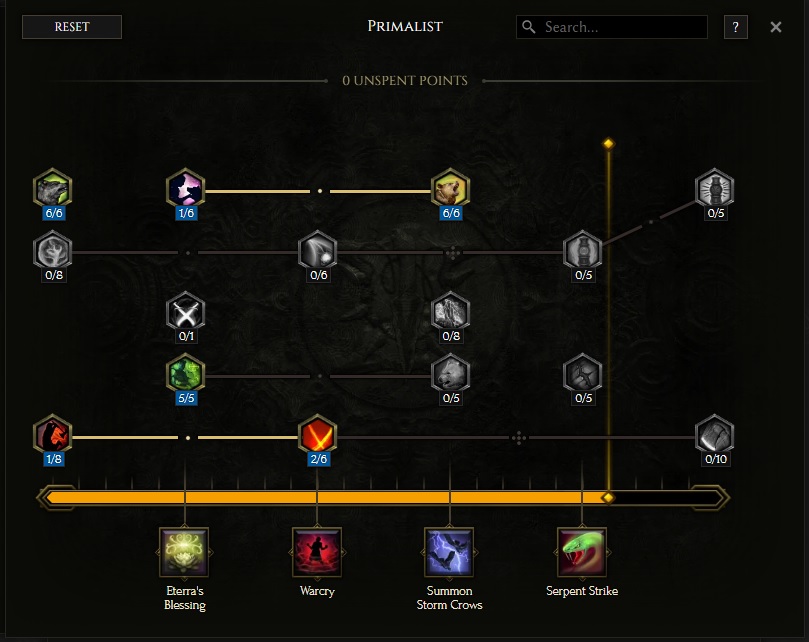
- 5 points into Gift of the Wilderness: Increases our Health and Minion Health.
- 3 points into Natural Attunement: Attunement and Lightning/Cold Resistance. You can trim, or add, points here if you need to cap these resistances based on your gear.
- 4 points into Hunter's Restoration: Increased Health and Health restored on hit every 3 seconds.
- 1 point into Primal Medicine: Increased Minion Damage and a portion of healing potions applied to minions.
- 1 point into Primal Strength: Strength and Health Regeneration, but we mainly take this to unlock the next node.
- 3 points into Survival of the Pack: Increased Melee Damage and Melee Life Leech for us and our minions.
- 5 points into Ancient Call: Added Health, Companion Health and faster Revival Speed.
Our base class is the Primalist, which acts as a generic caster, brawler, or companion summoner. Our character will be offered an opportunity to select an Advanced Mastery once we have completed the first act of the campaign. Each base class has three possible masteries to choose from. For the Primalist, we have access to the Mastery Tree Passives for Beastmaster, Shaman and Druid. Upon selecting a Mastery and placing 20 Passive Points into the Primalist Tree, you'll then be able to place Passive Points into the Mastery Trees.
For this build, we will be picking Druid as our advanced class. We will utilize the majority of our Passive Points in the Druid Passive Tree. Our Passive Points will be targeting nodes to increase damage while transformed into Swarmblade and boosting our survivability. Each of the Passive Trees and their points are broken down below.
Beastmaster Passive Points
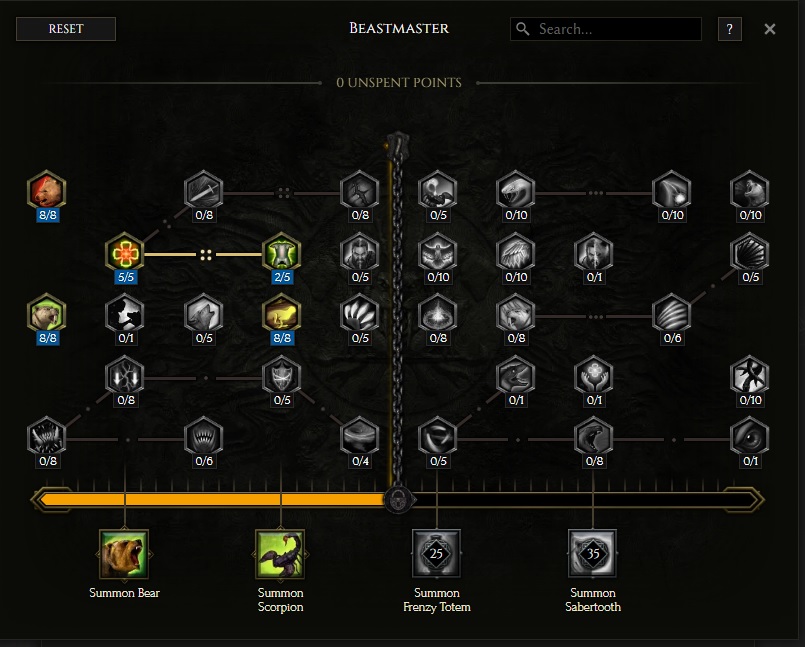
- 8 points into Ursine Strength: Gain Strength and Damage Reduction.
- 2 points into Feline Bond: Added Dodge Rating for us and our Minions, as well as increased Companion Revive Range
- 5 points into Boar Heart: Grants us Aspect of the Boar when hit by a melee attack.
- 8 points into The Chase: Increases Minion Attack and Cast Speed, Minion Movespeed and increased Companion Revive Speed.
Our base class is the Primalist, which acts as generic caster, brawler, or companion summoner. Our character will be offered an opportunity to select an Advanced Mastery once we have completed the first act of the campaign. Each base class has three possible masteries to choose from. For the Primalist, we have access to the Mastery Tree Passives for Beastmaster, Shaman and Druid. Upon selecting a Mastery and placing 20 Passive Points into the Primalist Tree, you'll then be able to place Passive Points into the Mastery Trees.
For this build, we will be picking Druid as our advanced class. We will utilize the majority of our Passive Points in the Druid Passive Tree. Our Passive Points will be targeting nodes to increase damage while transformed into Swarmblade and boosting our survivability. Each of the Passive Trees and their points are broken down below.
Druid Passive Points
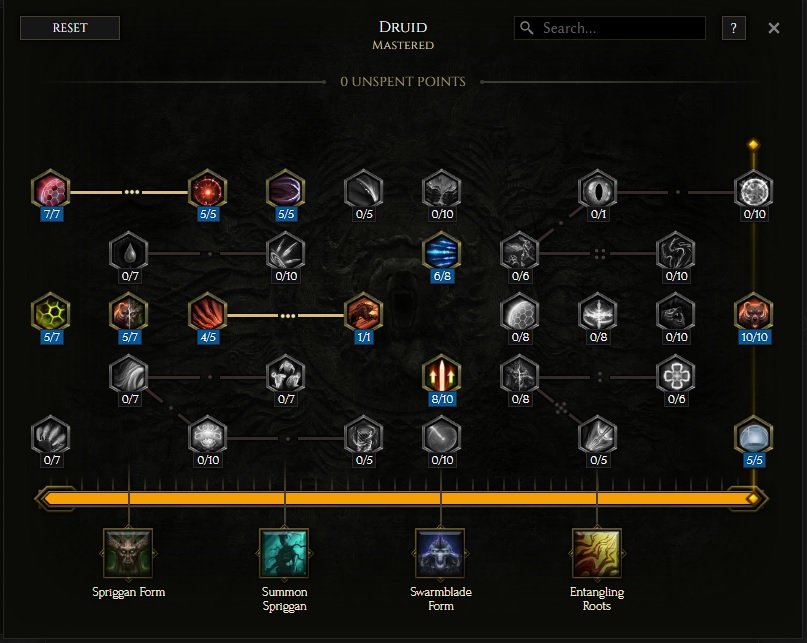
- 7 points into Chitinous Plating: Increases our Endurance and Armor.
- 5 points into Spirit Warden: Added flat Health and Mana.
- 5 points into Druidic Prowess: Added Strength and Attunement, as well as +1 to all our stats.
- 6 points into Claws of the Forest: Increased Physical/Poison damage for us and our minions.
- 5 points into Thicket of Thorns: Chance to cast
 Thorn Shield when we are hit, as well as increased Armor.
Thorn Shield when we are hit, as well as increased Armor. - 5 points into Focused Wrath: Increased Damage while transformed and, more importantly, reduced Rage Decay.
- 5 points into Wind in the Leaves: Increases our Attack and Cast Speed, as well as our minion's.
- 1 point into Rancour: No Rage Decay when out of combat. Take note, using any abilities counts as combat.
- 8 points into Force of Nature: Adds Physical Damage for melee and spell damage for us and our minions.
- 10 points into Hideskin: Adds Flat Health and gives additional Endurance Threshold based on our Maximum Health.
- 5 points into Impervious: Increases our Damage Reduction.
Our base class is the Primalist, which acts as generic caster, brawler, or companion summoner. Our character will be offered an opportunity to select an Advanced Mastery once we have completed the first act of the campaign. Each base class has three possible masteries to choose from. For the Primalist, we have access to the Mastery Tree Passives for Beastmaster, Shaman and Druid. Upon selecting a Mastery and placing 20 Passive Points into the Primalist Tree, you'll then be able to place Passive Points into the Mastery Trees.
For this build, we will be picking Druid as our advanced class. We will utilize the majority of our Passive Points in the Druid Passive Tree. Our Passive Points will be targeting nodes to increase damage while transformed into Swarmblade and boosting our survivability. Each of the Passive Trees and their points are broken down below.
Shaman Passive Points

- 6 points into Shamanic Infusion: Flat Attunement and Physical, Cold and Lightning Penetration.
In this section, we will break down each skill and highlight the key passives we have selected to make the skill perform as best as possible in the build. While some of these skills do allow for some variation to exist depending on your own custom choices, we recommend utilizing the skill trees as presented until you have a strong understanding of the build itself.
Summon Wolf
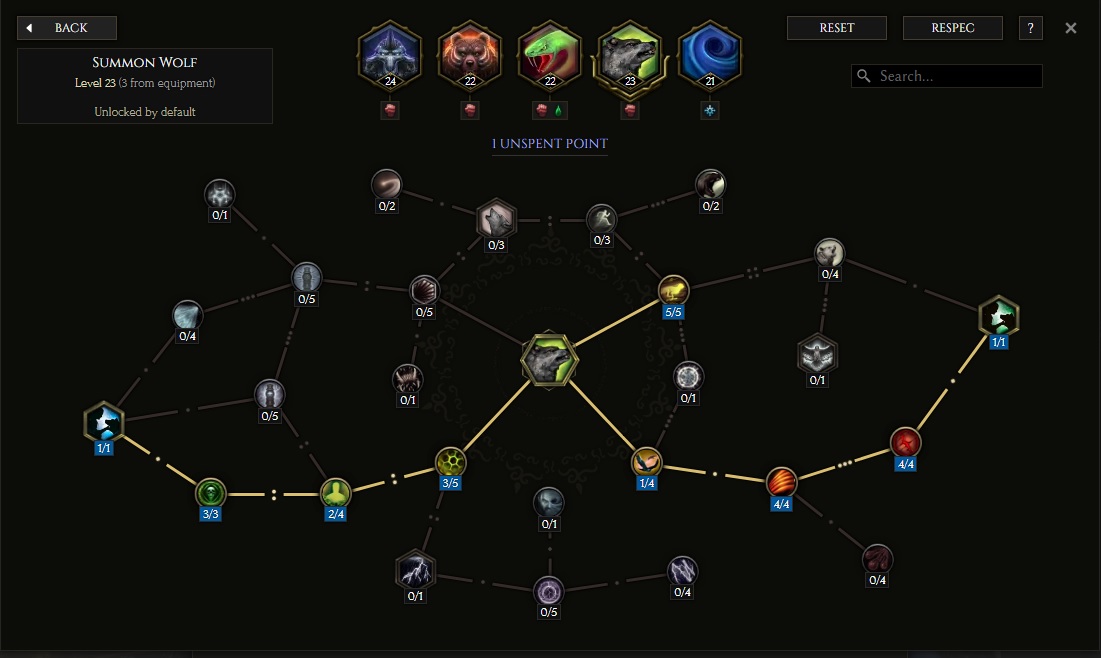
Our only permanent minions, which we double and transform into Squirrels thanks to the Unique Helmet, Herald of the Scurry. We focus our points on helping keep them alive, maximizing how many of them we get, and increasing how many Bleed stacks they can apply to enemies. Between some Minion Health mods on gear, leech effects from gear and passives, and increased Revive Range and Speed, the Squirrels end up being surprisingly easy to keep alive outside of boss fights. In boss fights, they will likely die a few times, unless you are very good at controlling them with the attack command (defaults to 'A' unless you have rebound it), but they also revive quite quickly.
Order of Skill Points
- 1 point into Canine Agility: Added Dodge Rating for our Squirrels and us.
- 4 points into Serrated Claws: Increased Melee Bleed Chance for our Squirrels.
- 1 points into Crippling Wounds: Increased Bleed Duration for our Squirrels and Chance to Slow on hit or when hit.
- 1 point into Safety In Numbers: Allows you to summon Wolves up to your Companion Limit.
- 2 point into Lupine Endurance: Increased Health for the Squirrels.
- 2 points into Wolfen Recovery: Flat and Increased Health Regen for your Squirrels.
- 3 points into Earthborn: Flat armor and Physical Damage Leech for your Squirrels.
- 1 point into Pack Hunters: Adds an extra wolf, which becomes two bonus Squirrels.
- 5 points into On the Hunt: Adds Attack Speed and Movement Speed for our Squirrels.
- 3 points into Patient Hunters: Wolves deal more Damage over Time and Bleeds they inflict have additional Physical Penetration.
If you don't have the 3 extra levels for the skill yet, you can skip the last 3 points.
In this section, we will break down each skill and highlight the key passives we have selected to make the skill perform as best as possible in the build. While some of these skills do allow for some variation to exist depending on your own custom choices, we recommend utilizing the skill trees as presented until you have a strong understanding of the build itself.
Swarmblade Form
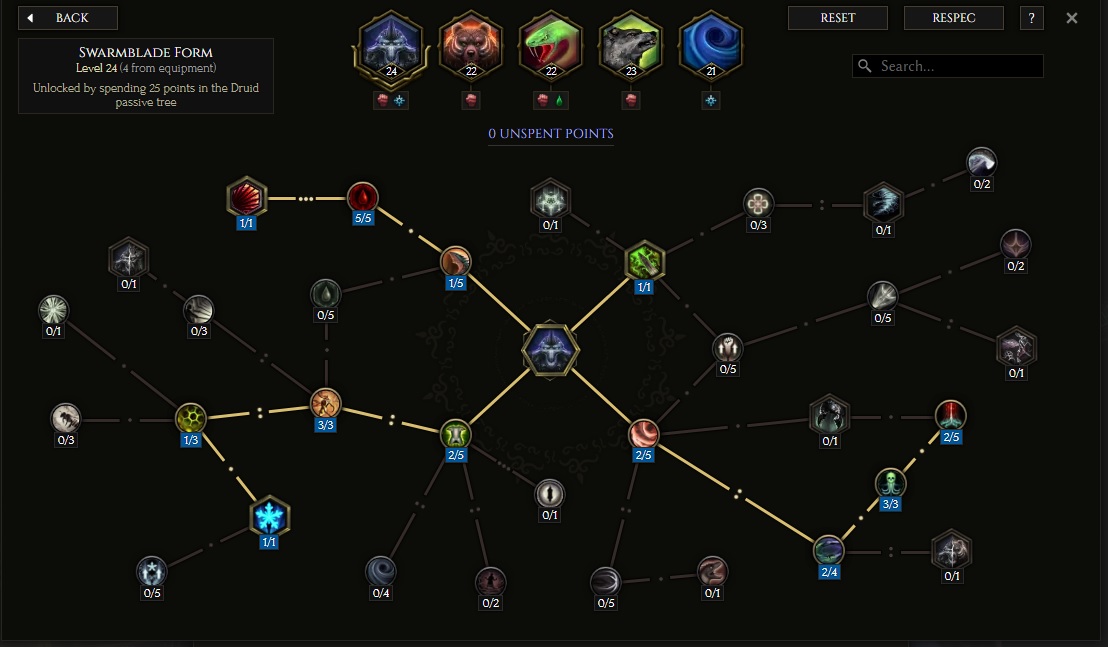
We want to spend as much time as possible in ![]() Swarmblade Form. When we are in this form, we
command our horde of Locusts and Squirrels (and sometimes a Snake!) to soften the enemy, applying a ton of
Bleed stacks that we consume to create a high damage Locust Swarm to annihilate enemies.
Swarmblade Form. When we are in this form, we
command our horde of Locusts and Squirrels (and sometimes a Snake!) to soften the enemy, applying a ton of
Bleed stacks that we consume to create a high damage Locust Swarm to annihilate enemies.
Due to the passive Bloodlust Swarm, we will get a large amount of increased damage from consuming all Bleed stacks. This node used to be the keystone of the entire build, but since it's nerf, we are focusing on increasing our minion damage a bit more. We can still reach upwards of 5,000% increased damage on bosses, when you consume a full 999 stacks. Therefore, any other Increased Damage modifiers are very low priority, as they stack additively with this bonus and are relatively low impact. Mods that increase our minion damage or penetration are a bit higher priority. We instead focus on survivability for us and our minions, as well as stacking as much Bleed as we can, as fast as possible.
Order of Skill Points
- 1 point into Wasp Flight: Increases our Attack and Cast Speed.
- 5 points into Death by a Thousand Wings: Increases Bleed chance from Armblade and Dive as well as the Locusts' Bleed Chance.
- 1 points into Bloodlust Swarm: Despite it's nerf, this is still a very strong node, giving a large amount of increased damage to our Locust Swarm.
- 2 points into Slashing Spiral: Increased area for Swarm Strike, Locust Swarm and our Locust's Melee attacks.
- 3 point into Neverending Drove: Increased Locust Swarm Duration and hit damage for Swarm Strike.
- 2 points into Locust Agility: Added flat Dodge Rating and Armor for us and our Locusts while we are in Swarmblade form.
- 3 points into Grand Colony: Increases the maximum amount of Locusts we can have, and how many Locusts each Hive can spawn.
- 3 points into Bountiful Hibernacula: Gives us health and rage when a Locust is released from a hive. This allows us to potentially stay in Swarmblade form indefinitely, if you are constantly consuming locusts and placing new hives.
- 1 point into Viper's Call: This makes our Armblade Slashes adopt the nodes from the
 Serpent Strike skill tree.
Serpent Strike skill tree. - 3 points into Plague of Locusts: Adds more damage for Locust Swarm for each Locust consumed.
If you do not have the extra levels to ![]() Swarmblade Form yet, you can skip the last 3 points. If you have extra points, or feel a bit squishy, you could
trim a point from Neverending Drove and Plague of Locusts for points in Vampiric Mandibles for more leech.
Also, in testing, the duration of Locust Swarm seemed to be lasting a very long time, sometimes forever. It may be a temporary bug, but if you are encountering this, you could trim all
but 1 point from Neverending Drove and fill out any of the nodes that you wish.
Swarmblade Form yet, you can skip the last 3 points. If you have extra points, or feel a bit squishy, you could
trim a point from Neverending Drove and Plague of Locusts for points in Vampiric Mandibles for more leech.
Also, in testing, the duration of Locust Swarm seemed to be lasting a very long time, sometimes forever. It may be a temporary bug, but if you are encountering this, you could trim all
but 1 point from Neverending Drove and fill out any of the nodes that you wish.
In this section, we will break down each skill and highlight the key passives we have selected to make the skill perform as best as possible in the build. While some of these skills do allow for some variation to exist depending on your own custom choices, we recommend utilizing the skill trees as presented until you have a strong understanding of the build itself.
Serpent Strike
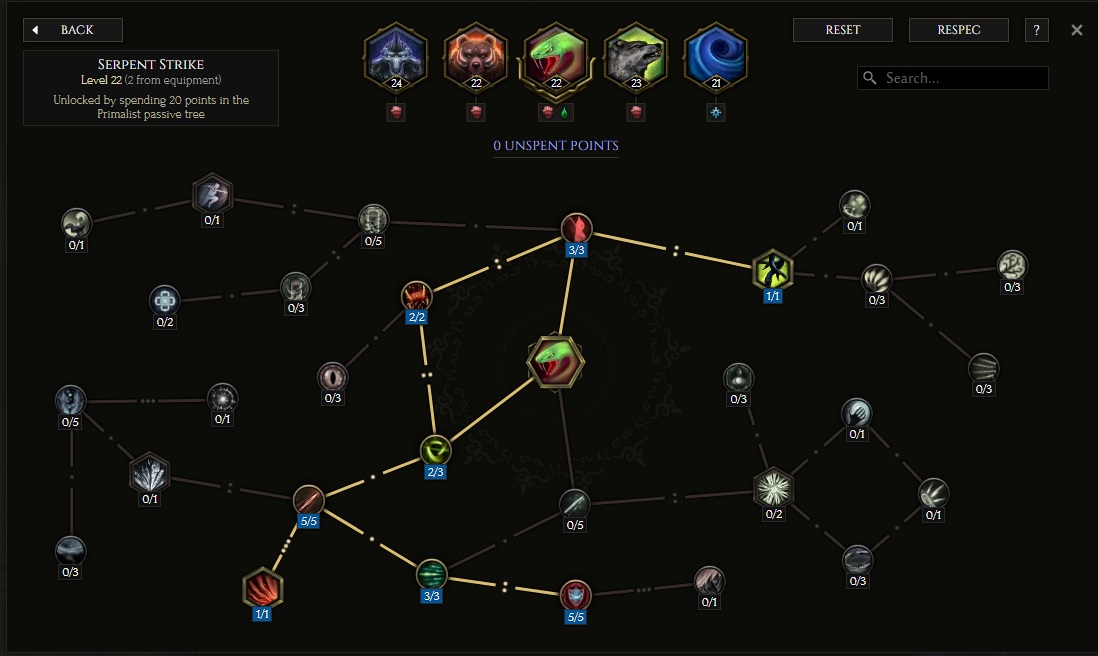
This skill, as well as ![]() Maelstrom are not super important to the build. However, since the Armblade slash in
Maelstrom are not super important to the build. However, since the Armblade slash in ![]() Swarmblade Form can
benefit from the
Swarmblade Form can
benefit from the ![]() Serpent Strike tree, we gain a few small, but noticeable, bonuses from speccing into the tree as well. We gain a
Kill Threshold, Armor Shred, and we can pump a bit of extra Bleed stacks from our own attacks. However, the vast majority
of Bleed stacks will be generated by our minions.
Serpent Strike tree, we gain a few small, but noticeable, bonuses from speccing into the tree as well. We gain a
Kill Threshold, Armor Shred, and we can pump a bit of extra Bleed stacks from our own attacks. However, the vast majority
of Bleed stacks will be generated by our minions.
Order of Skill Points
- 3 points into Slither: Added Dodge Rating whenever we use
 Serpent Strike.
Serpent Strike. - 5 points into Gouging Spear: Increased Bleed Chance.
- 1 point into Swirling Carnage: Added Bleed Chance for each stack of
 Maelstrom.
Maelstrom. - 3 points into Hydra Strikes: Increased Attack Speed.
- 3 points into Culling Point: Adds an 18% Kill Threshold.
- 2 points into Devour Prey: Health gained on kill or crit.
- 5 points into Corrosive Venom: Armor Shred chance.
- 1 point into Primal Serpent: Adds a chance to summon a temporary minion when we kill an enemy or hit a rare or boss.
- 1 point into Guardian Spear: Heals the current Serpent and buffs it's damage when you would summon a new one.
- 1 point into Vicious Strikes: Gives the Serpent more Attack Speed and a Health on Hit effect.
If you don't have the extra levels from gear yet, you can skip the last points in the list. They are listed roughly in order of importance. If you have 2 more points, from a max rolled Plague Dragon's Tongue, you can put them into Vicious Strikes, but this is pretty low impact.
In this section, we will break down each skill and highlight the key passives we have selected to make the skill perform as best as possible in the build. While some of these skills do allow for some variation to exist depending on your own custom choices, we recommend utilizing the skill trees as presented until you have a strong understanding of the build itself.
Maelstrom
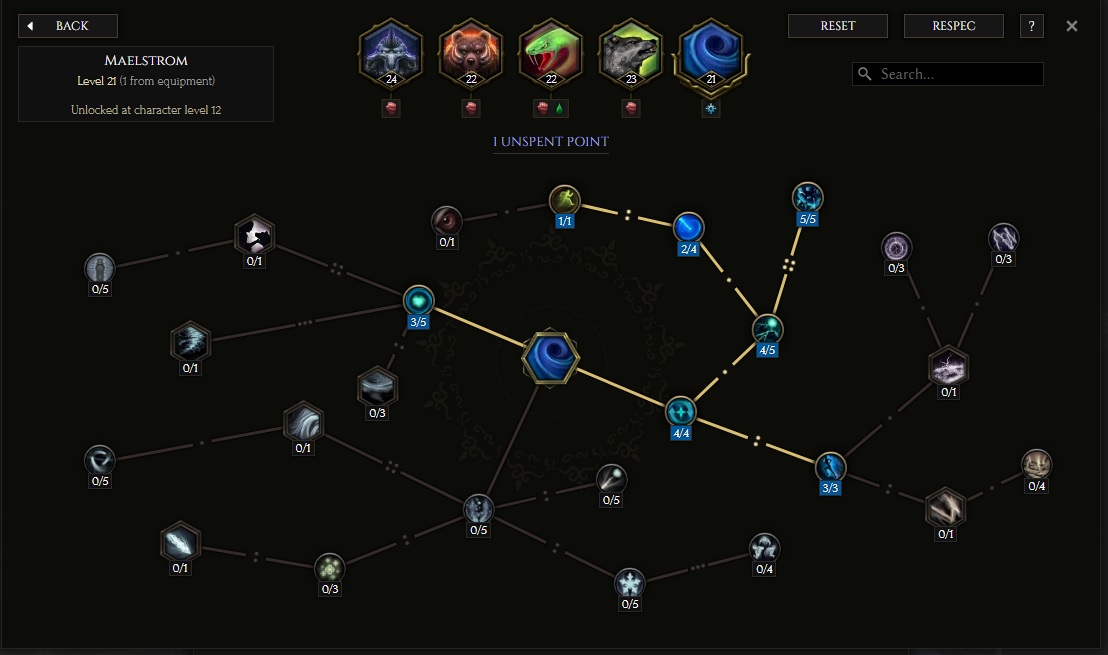
As stated previously, this skill is not a high damage part of the build. We run it simply for some of the passive bonuses we gain, such as haste, as well as the passive heal and dodge it adds. You will not directly cast this ability, as the idols and chance to cast on kill or hitting a rare/boss will trigger the stacks for you.
Order of Skill Points
- 4 points into Whirlpool: Increased Stack Duration.
- 4 points into Turbulence: More damage for
 Maelstrom.
Maelstrom. - 2 points into Growing Storm: Chance to cast
 Maelstrom on kill or hitting a rare/boss enemy.
Maelstrom on kill or hitting a rare/boss enemy. - 3 points into Calm: Reduced Mana cost.
- 1 point into Windswept: Grants Haste whenever you have 6 or more stacks.
- 1 point into Windfury: Grants Frenzy when you have 6 or more stacks.
- 2 points into Sleet-Footed: Added Dodge Rating per
 Maelstrom stack.
Maelstrom stack. - 1 point into Cyclone: Converts
 Maelstrom to physical damage, which is the main thing we are scaling in the build.
Also changes it's chill chance to slow chance, which has some added benefits elsewhere in the build, as well as being a more reliable defensive ailment.
Maelstrom to physical damage, which is the main thing we are scaling in the build.
Also changes it's chill chance to slow chance, which has some added benefits elsewhere in the build, as well as being a more reliable defensive ailment. - 2 points into Arctic Chill: Adds a Chill chance per second (converted to slow chance due to previous node).
- 2 points into Healing Winds: Adds Healing per Second to yourself and allies inside it's area.
As with other skills, if you do not have all the extra points from gear yet, you can skip the last few passives listed.
In this section, we will break down each skill and highlight the key passives we have selected to make the skill perform as best as possible in the build. While some of these skills do allow for some variation to exist depending on your own custom choices, we recommend utilizing the skill trees as presented until you have a strong understanding of the build itself.
Summon Thorn Totem

This should be the last skill you specialize into, as we need to obtain an idol with the 'Chance to cast Thorn Totem on hit' before we can utilize the skill. We cannot manually cast it while in Swarmblade form, so the idol is the main way we get the totems out. Once you have obtained an idol with that mod, it will trigger fairly consistently, and summon the max totems in the process.
Order of Skill Points
- 4 points into Forested Expanse: Adds 4 more totems, but also increases the mana cost.
- 4 points into Eternal Forest: Increased Duration and Health for the totems.
- 1 point into Grove Mind: Summons your max number of totems in a ring, but reduces the max number of totems by 1 and adds additional mana cost.
- 3 points into Torrent of Thorns: Chance to fire double projectiles.
- 4 points into Lethal Thicket: Increased Critical Chance and 20% more damage for your Thorn Totems.
- 1 point into Titan's Bane: Thorn totems only fire one projectile, but they have increased cast speed, accuracy and more damage against Rare/Boss enemies.
- 2 points into Spriggans' Wrath: Thorn Totems can pierce 2 additional enemies.
Build Mechanics and Playstyle
The build is a VERY fast farmer, as once you have a decent Locust Swarm active, you are doing damage constantly without stopping to cast or attack. Between your passive AoE Damage and your Minions automatially nearby attacking enemies, you can clear a lot of easy enemies in the blink of an eye. On tankier enemies, or especially bosses, you'll want to let the bleed stacks get up to a high number before you use Swarm Strike to consume the stacks as well as your close Locusts. Then, either let your hives re-summon some more locusts or put down more hives if you don't have all 3 out anymore.
The basic playstyle rotation is to summon all three of your hives before engaging the enemies. Wait a moment for the Locusts to spawn, then send all your minions to attack the tankiest enemy you can see. As they get low on Health, or you see that there is a good amount of Bleed stacks on them, you'll want to position to consume the most amount of Bleed stacks and Locusts at the same time with Swarm Strike. This will trigger Locust Swarm, ideally killing everything with a single tick of damage, letting you just run straight through every enemy for a bit. You'll want to keep casting new Hives as you get out of range of the old ones, so that you keep gaining rage from the release of the Locusts, allowing you to stay in Swarmblade Form longer. With some practice, you'll get a feel for the balance needed to stay in the form indefinitely. Remember, when you are already at your max Locust count, the hives cannot summon more out. So, you need to consume some of them with Swarm Strike periodically.
If you are attempting the above rotation and feel like it's not working for you, we suggest you go to the training dummies near the Arena to practice the rotation a bit. You can watch the enemy's Bleed stacks and you'll get a feel for how many max stacks your minions can hit and how long it takes to stack it. Maximizing how many stacks they have before you consume them with Swarm Strike is the key to maximizing your damage, especially on bosses.
Equipment and Gear Affixes
For this build, we will be focusing on several main affixes for each piece of non-unique gear, as well as working towards acquiring the specific uniques needed to make this build operate correctly. Our equipment will focus on these specific affixes for the Implicits and Modifier stats.
| Gear Slot | Implicits | Modifiers |
|---|---|---|
| Two-Handed Spear | Plague Dragon's Tongue | Legendary Potential Increased Physical Damage Shared Increased Bleed Duration |
| Helmet | Herald of the Scurry | Legendary Potential Chance to apply Bleed on Minion Hit Shared Increased Bleed Duration |
| Chest | Doublet of Onos Tull | Legendary Potential Level of Swarmblade Form Chance to apply Bleed on Minion Hit |
| Gloves | Armor % of Armor applies to Damage Over Time |
Prefixes Strength Increased Area for Area skills Suffixes Hybrid Health Armor/Reduced damage from Criticals |
| Ring | Needed Resistances Increased Cooldown Recovery Speed All Attributes |
Prefixes Strength Increased Minion Damage/Health Suffixes Health Endurance Needed Resistances |
| Amulet | Physical and Necrotic Resistances | Prefixes Physical Penetration Increased Area for Area Skills Suffixes Health Needed Resistances Chance to apply Frailty on Hit |
| Belt | Thorn Slinger | Legendary Potential Armor/Reduced damage from Criticals Increased Minion Damage Endurance |
| Feet | Armor Movement Speed Reduced Bonus Damage from Critical Strikes |
Prefixes Strength Movement Speed Suffixes Hybrid Health Flat Health |
| Relic | Dedication of an Erased Primalist | Weaver's Will Needed Resistances Increased Minion Damage |
Budget Planner
If you are still in the campaign, or in early monoliths, you can use the gear listed here, Starter Gear Planner, as a baseline gear template for the build as you farm for the suggested uniques.
Uniques
Now, let's look at the required Uniques for this build.
Herald of the Scurry
Herald of the Scurry: While it might seem that the Helmet is necessary for the build to function, it can be played with regular Wolves. They will just stack up less bleed stacks. This is a big decrease to our damage, which is why it is preferred to have it, but if you are leveling with the build and trying to farm the gear, this item is not strictly necessary. It should still be one of the first items you go for, even without Legendary Potential.
Doublet of Onos Tull
Doublet of Onos Tull: Similar to the Helmet, the Doublet is simply a large increase in damage. We want to stack as much bleed chance and duration for our minions as possible. However, the Doublet is a very common item, and finding one with 1 or 2 Legendary Potential shouldn't be too hard or too expensive (if you are in Merchant's Guild). It's not included in the planner, but this was the old chest the build used prior to 1.1, and it's still a solid option, but since we aren't going 'all in' on the damage like before, the next body armor below is better overall.
Wall of Nothing
Wall of Nothing: Once again, this unique is not strictly necessary to the build. You can use the Doublet listed above for a long time, and it provides more damage than the Wall of Nothing, but eventually you'll need the extra survivability that this unique provides if you wish to push corruption or farm Harbingers and Aberroth. It's not recommend to swap to a LP0 Wall of Nothing over an LP2 Doublet of Onos Tull. Wait until you have an LP1 or LP2 with a good slam on it before swapping.
Thorn Slinger
Thorn Slinger: The extra level to Physical Skills is important for us to get all the passives in ![]() Swarmblade Form that we want.
All of the nodes taken in that skill tree are very good and add worthwhile abilities.
Swarmblade Form that we want.
All of the nodes taken in that skill tree are very good and add worthwhile abilities.
Dedication of an Erased Primalist
Dedication of an Erased Primalist: Similar to Thorn Slinger, we run this to get all the necessary skill points. The Weaver's Will mechanic can make it very random which affixes you'll get, but aim for fixing any Resistances you need, which will likely be Physical Resistance if you are following the rest of the guide, and then improving survivability when possible. If you are in Merchant's Guild, you can either buy base versions and roll them yourself, or try to find one that already has some of the affixes you need. If you are Circle of Fortune, you could replace this with your best rare or exalted Relic until you find a suitable one yourself.
Idols
Idol slots are gained through the campaign, unlocking small bonuses and unique affixes for the player to discover and augment their builds with. The Idol screen consists of a grid system for the player to fill out with different sized idols, eventually filling in every part of the grid. As the Idol shape increases (1x1, 1x2, 1x3, 1x4, etc.) the stronger an affix you might find for your build.
When farming for gear, you can use your Idol Slots as flex spots to fix any resistances you may need. As your resistances improve on your base gear, you can start replacing your idols with the ones below.
Size: 3×1
Modifiers
- Increased Damage over Time while Transformed (less important)
- Chance to apply Bleed on Minion Hit (most important)
Size: 4×1
Modifiers
- Chance on hit to summon a Thorn Totem
- Increased Minion Melee Attack Speed
Size: 1×3
Modifiers
- Chance to cast Maelstrom every 3 seconds
- Shared Increased Damage over Time
Blessing
Blessings are permanent buffs that are permanently applied to your character. These come in two different powers, Standard and Grand. Grand blessings are significantly stronger than the Standard Blessings. In total, there are 10 Blessing Slots, one for each Monolith Timeline. When you complete a Monolith and defeat the final boss you will be awarded a choice of three blessing with a random value.
| Blessing Name | Affix | Timeline |
|---|---|---|
| Void Resistance | The Black Sun | |
| Ward per Second | Ending the Storm | |
| Increased Armor | The Age of Winter | |
| Flat Armor | Spirits of Fire | |
| Increases All Resistance | Reign of Dragons |
The Blessings listed above cover the most important slots, with the remaining Blessing Slots being filled with whatever the player may be trying to target farm.
Changelog
- 24 Jul. 2024: Updated for 1.1, post-nerf
- 29 Mar. 2024: Guide added.

This guide has been written by Enzee, an active theorycrafter in the ARPG community, actively creating build guides for Last Epoch and Path of Exile.
- Last Epoch Season 3 Overhauls Skills, UI, Monster Behavior & More
- Last Epoch Season 3 Adds Smarter Minions & Big Changes
- Lich & Necromancer Get New Skill, Buffs, and Dark New Builds in Last Epoch!
- Last Epoch Season 3 Explores the Ancient Era!
- Last Epoch Reveals Major Content for Season 3!
- Last Epoch Season 3 Trailer Reveals Major Changes!
- Last Epoch Devs Bought by Krafton — Fans Fear Another Subnautica 2
- Last Epoch Season 3: New Teaser, Goats, and Big Changes Ahead

